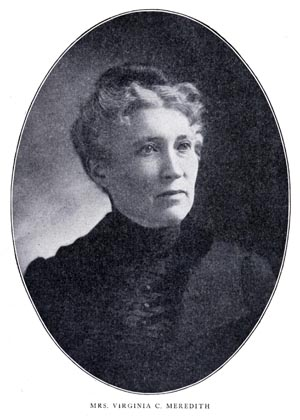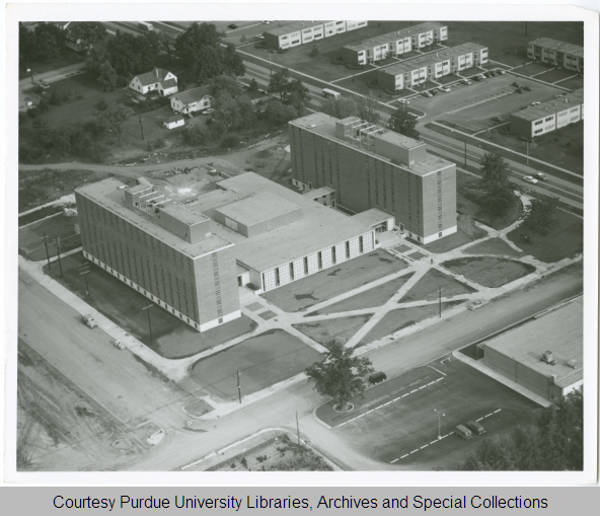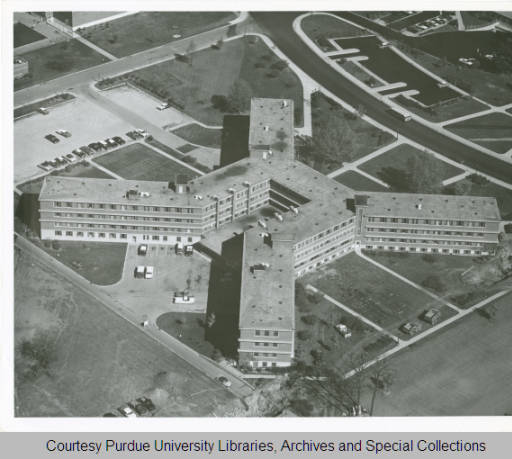Posted on November 14, 2019 by small20
Meredith Hall
by Zoe Malavenda
While walking around campus, students pass building after building, each one named after a different person. Do they ever stop to think, who are these people and why is this building named after them? Each one of these namesakes has a story, one that is not often known or recognized by the students that inhabit these buildings each day.

Meredith Hall
Built in 1952, Meredith Hall, originally named “X” Hall, became what is now the home to over 600 female students [1]. Virginia Meredith was an influential woman in agriculture and business coining the name, “Queen of American Agriculture.” Virginia was born in Indiana in 1848 to the son of a Virginian and was named after his home state. When her husband of ten years, Henry Clay Meredith, died, Virginia assumed all responsibility of the family business of four hundred acres and at the age of thirty-two began her forty year journey of buying and selling pure-bred cattle, holding public sales, and analyzing her labor and utilization records to find what farmers needed. Due to her knowledge of livestock and breeding Virginia received invitations to speak at breeder’s conventions. It wasn’t long before Virginia became a nationally known female farmer, speaking at Farmer’s Insitutes and giving speeches on various agricultural subjects in a time where women rarely ran farms or delivered public speeches [2]. The most notable speech given by Virginia was in Vicksburg, Mississippi. She captivated the audience with her knowledge and a tribute to an idol of the south, Henry W. Grady. Following her speech was the roar of the crowd and cheers of which overwhelmed her. After her final address in Vicksburg, Virginia was awarded a gold medal with the inscription, “The Citizens of Vicksburg, Mississippi to the Queen of American Agriculture,” [2]. In addition to her service in agriculture, Virginia was very passionate about home economics. It was a dream of hers to see a home economics program at Purdue University that would prepare women for their lives’ work, just as agriculture did for men. When her ideas were not accepted at Purdue, she received an offer from the University of Minnesota in 1896 to establish their departments of home economics. After six years of service in Minnesota, Virginia returned to Indiana [2]. Virginia was passionate that home-making was just as much a profession as what men were doing at the time, learned professions like law and medicine. In an interview with Indianapolis News in 1990, Virginia stated, “This I consider the finest work I have done, though far from being as pleasant as farming. There are now sixty young women enrolled with 230 men. The course is unique – broad enough to embrace home science in all its phases, including the study of horticulture, gardening, elementary agriculture, poultry, and breeds of live stock,” [4]. Her passion for home economics to be seen as a legitimate science combined with her work at the University of Minnesota, inspired home economics classes to be created at Purdue. In 1926, twenty-one years after the first home economics classes, Purdue established the department of home economics led by the first dean, Mary Matthers, the adopted daughter of Virginia Meredith. Virginia is commonly remembered for her role as the first female member of the Purdue board of trustees selected in 1921 [3]. In addition to this title, she was also the first president of the Indiana Home Economics Association, being reelected two times. At the age of eighty-eight, Virginia Meredith died in her West Lafayette home. Her legacy continues to live on at Purdue University as Meredith Residence Hall houses over 600 female students attending the university and doing what Virginia always hoped women could.

Shreve Hall
The first co-education residents hall, Shreve Hall, was named after the late Eleanor Shreve [6]. Eleanor was an author, educator, world traveler, musician, and constructive activist [7]. At the peak of radio entertainment, Eleanor conducted scenarios for radio. She was active in the League of Women’s Voters, the Purdue Women’s Club, the Women’s Guild of St. John’s Episcopal Church, and served on the Board of Directors of the Tippecanoe County Historical Association [8]. Mrs. Shreve along with her husband were very passionate about their involvement with students both inside and outside the classroom. They frequently hosted students from many origins in their home and Eleanor often sang along with them. Eleanor and her husband were very active in the creation of the Taiwan College of Engineering in Formosa. A distinguished Chemistry professor, Mr. Shreve assisted in developing the engineering education while Eleanor taught English and worked to create an understanding and relationship between peoples of different nationalities and backgrounds [9]. It is fitting that Shreve hall was the first co-educational residence hall on Purdue’s campus as the work of Eleanor Shreve was done so alongside her husband, Randolph. Eleanor and Randoplh had a shared interest in stones and stone carvings particularly jade in which they acquired a large collection during their world travels [9]. Their love for jade can still be recognized in the Shreve Hall Jade Room and their collection is housed at the Indianapolis Museum of Art.
As Shreve Hall was named after Eleanor specifically, I think it is important to note the lack of information kept on Eleanor independently of her husband, Randolph. In researching the legacy of Eleanor Shreve, a dead end was hit many times. Why is there only information on the life of Eleanor Shreve as it relates to the life of Randolph? Eleanor accomplished enough on her own to have a residence hall named after her and yet, there is very little about these accomplishments in the records at Purdue and other online resources.
[1] Meredith Hall Records, Box 1, Purdue Archives and Special Collections, UA 80, Series 1, File 1
[2] Bartholomew, H. S. K. “Virginia C. Meredith.” Indiana Magazine of History 35 (March 1939): 49-57.
[3] Virginia Claypool Meredith. Virginia Claypool Meredith. Accessed December 11, 2019. https://mrlinfo.org/history/biography/meredithvc.htm.
[4] “Virginia Claypool Meredith.” IHB: Virginia Claypool Meredith. Accessed December 11, 2019. https://www.in.gov/history/markers/4102.htm.
[6] Shreve Hall. Purdue Libraries. Accessed December 11, 2019. http://collections.lib.purdue.edu/campus/buildings/89.
[7] “Shreve Hall History.” History – Housing at Purdue University. Accessed December 11, 2019. https://www.housing.purdue.edu/Housing/Residences/Shreve/history.html.
[8] Malavenda, Zoe, “Plaque for Mary Matthews,” December 2, 2019
[9] Randolph Norris Shreve Papers, Box 6, Purdue Archives and Special Collections, MSF 344
IMAGES
[10] Meredith Hall. University Residences. Purdue University. Accessed December 11, 2019. https://housing.purdue.edu/CampusGuests/ConferenceServices/FlyerMeredith.html.
[11] Virginia Claypool Meredith. Virginia Claypool Meredith. Accessed December 11, 2019. https://mrlinfo.org/history/biography/meredithvc.htm.
[12] Clarke, Gracie Julian. “Activities of Woman’s Clubs.” The Indianapolis Star, February 9, 1913. https://indystar.newspapers.com/image/8711833/.
[13] Shreve Hall. Purdue Libraries. Accessed December 11, 2019. http://collections.lib.purdue.edu/campus/buildings/89.
[14] “Shreve Hall Is Newest Purdue Residence Unit.” Journal and Courier. September 15, 1970, 51 edition, sec. 221.
Banner Image Reference: Purdue Archives and Special Collections
